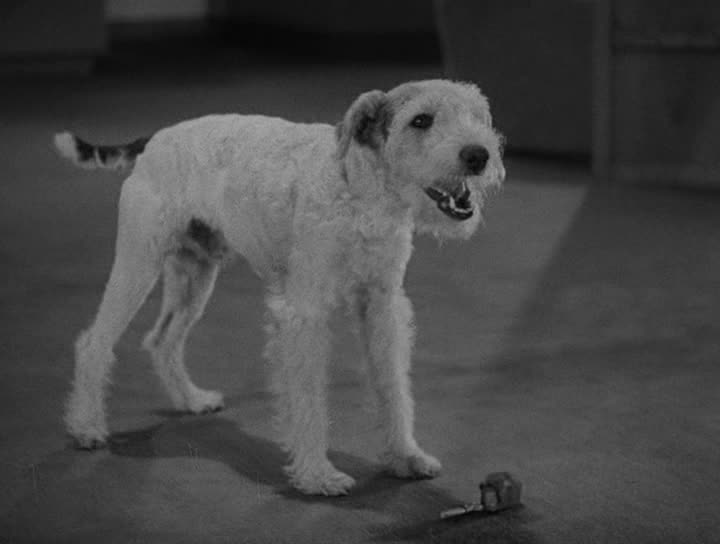Shadow of the Thin Man

1941![]()
Story by Harry Kurnitz
Screenplay by Harry Kurnitz and Irving Brecher
Directed by W. S. Van Dyke

Shadow of the Thin Man is the last of the classic four Thin Man films before the large drop in quality of the final two flicks. Dashiell Hammett doesn’t help provide the story, and Frances Goodrich and Albert Hackett have also moved on, leaving the writing in the hands of Harry Kurnitz and Irving Brecher (Kurnitz also developing the story) Director W. S. Van Dyke returns for his last Thin Man entry.
Shadow of the Thin Man was released November 21, 1941, on the eve of the US’s entrance into World War II with the bombing of Pearl Harbor. None of the ongoing worldwide conflict is reflected in the film, which involves murder and horse gambling conspiracies. The only real acknowledgement of real world events seems to be the rolling back of displays of Nora’s wealth, though it is still obvious they are flushed with money.
The Thin Man flicks zigzag back and forth between New York and San Francisco, so we return to the Bay Area for good time Bay Area fun. Also returning is Lieutenant Abrams (Sam Levene) from After the Thin Man, because we’re back on his beat. Once again he needs Nick Charles’ help, because of mystery murders with lots of complications.

Murder victim “Whitey” Barrow (Alan Baxter) is one of those obvious murder victims. Baxter’s also ridiculously overacting when he’s playing the tough mobster guy, yet sounds like a normal person when he’s hiding his gangster persona. It’s a weird choice (and frankly a bit distracting), luckily he gets knocked off early enough it doesn’t become a big problem.
Nora keeps up with Nick’s investigations the most in this sequel, following him on his searches, showing him up when it comes to dealing with his son, and even luring him home with the siren song of a shaking martini mixer. There are bonus points added for Nora heroically leaping onto a gun during the climactic scene where the real murderer reveals themselves by grabbing the gun they always have.
Aside from Nora Charles, most of the female roles are pretty thankless, despite being filled with quality actresses. Stella Adler manages to turn the limited role of Claire Porter into something amazing. Porter is drenched in the casings of the upper class, appearing to be well-to-do despite her gangster boyfriend. But her money comes from a job not so well-to-do, a job they can only hint at (due to the Hays Code) by her switching up accents when flustered by Nick Charles. Donna Reed has the truly thankless role as the secretary girlfriend to the accused murderer Paul. Despite a hint that she might be more than she looks due to who she works for, her character is given little to do except worry about her man.
Louise Beavers’ character of Stella, the Charles’ maid, is the largest part for a black actor in the Thin Man series. Sadly it’s what I call a Mammy Whammy, in that it’s over the top servant character. Beavers is associated with that type of role, partially because those roles were the only roles available to black performers. She gained fame with a non-stereotypical black maid role, Delilah in 1934’s Imitation of Life.

This is the Thin Man entry with some of the funniest bits in the series – the wrestling scene, the merry-go-round, the brawl at the restaurant, Nick getting a speeding ticket, and Nick’s encounter with an old landlady obsessed with radio crime shows and police gazettes, who talks Nick’s lingo and then some.
One of the major criticisms is the film focuses on too much that isn’t the murder mystery, and the sequence of events that the mystery follows are practically spelled out. It is true that things seem almost designed to happen no matter what Nick and Nora do, they are practically swept up into the original murder and are present at every important event following it, complete with the police actively encouraging them. The killer is the most obvious of the whole series, but my view on the films are that it is about the journey, not the destination. After being raised on two decades of carbon-copy police procedurals where the real differences are the show’s characters and gimmicks, which quickly become the defining reason to watch. The old detective movies that are memorable have their own cool characters and gimmicks, of which the Thin Man flicks excels. I don’t think Shadow of the Thin Man is a shadow of the prior films (BOOOOO!!! to that pun!), instead standing tall with the original four despite a few flaws.


|




















